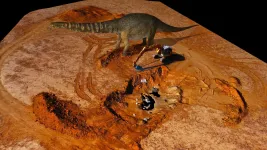(Press-News.org) Rockville, Maryland (June 7, 2021) -- There has been a long-standing debate as to whether a low-fat or a plant-centered diet is better at lowering the risk of cardiovascular disease. A new study that followed more than 4,700 people over 30 years, found that a plant-centered diet was associated with a lower long-term risk for cardiovascular disease. However, both diets were linked with lower LDL, or bad cholesterol, levels.
"Since 1980, dietary guidelines in the United States and in Europe have recommended eating low amounts of saturated fat because of the high rates of heart disease in these regions," said research team leader David Jacobs, PhD, from the University of Minnesota. "This is not necessarily wrong, but our study shows that plant-centered diets can also lower bad cholesterol and may be even better at addressing heart disease risk."
The plant-centered diet emphasizes fruit, vegetables, legumes, whole grains, nuts and seeds, low-fat dairy, and fish. It also limits high-fat red and processed meats, salty snacks, sweets, and sugar-sweetened soft drinks. The low-fat diet is based on the Keys Score, a good formulation of the "low saturated fat" message, driven by saturated fat, but also including polyunsaturated fat and dietary cholesterol.
Yuni Choi, PhD, a postdoctoral fellow in Jacobs' lab will present the research as part of NUTRITION 2021 LIVE ONLINE, a virtual conference hosted by the American Society for Nutrition (ASN).
"Our findings show that it is important to view diet quality from a holistic perspective," said Choi. "Targeting just single nutrients such as total or saturated fat doesn't take into account the fats that are also found in healthy plant-based foods such as avocado, extra virgin olive oil, walnuts and dark chocolate -- foods that also have cardioprotective properties and complex nutrient profiles."
The new research is based on participants in the four U.S. clinics of the Coronary Artery Risk Development in Young Adults study (CARDIA), which enrolled 5115 Black and white men and women in 1985-1986. During more than 30 years of follow up, there were 280 cases of cardiovascular disease, 135 cases of coronary heart disease, and 92 cases of stroke among the study participants.
To assess eating patterns, the researchers conducted three detailed diet history interviews over the follow-up period. These diet history questionnaires determined what participants ate and then asked them to list everything consumed in that category. For example, participants who reported eating meat in the past 30 days would be asked what meat items and how much they consumed. This was repeated for around 100 areas of the diet. Based on this information, the researchers calculated scores for all participants based on both the Keys Score of the A Priori Diet Quality Score (APDQS), which captures the plant-centered diet.
After accounting for various factors including socioeconomic status, educational level, energy intake, history of cardiovascular disease, smoking and body mass index, the researchers found that having a more plant-centered diet (higher APDQS Scores) and consuming less saturated fat (lower Keys Scores) were both associated with lower LDL levels. However, lower LDL levels did not necessarily correlate with lower future risk of stroke. Higher APDQS scores, but not lower Keys Scores, were strongly associated with a lower risk for coronary heart disease and stroke.
"Based on our study, we suggest that people incorporate more nutritionally-rich plant foods into their diets," said Choi. "One way to do this is to fill 70 percent of your grocery bag with foods that include vegetables, fruits, whole grains, nuts, legumes, coffee and tea."
The researchers are carrying out a variety of studies looking at how the APDQS diet score relates to various health outcomes. They are also interested in studying how different diets affect gut bacteria, which is known to influence many aspects of health and disease.
Choi will present this research on-demand during the NUTRITION 2021 LIVE ONLINE Dietary Patterns, Diet Quality, and Health 2 session from noon on Monday, June 7 through 5:30 p.m. on Friday, June 10 (abstract; presentation details).
Image available.
Please note that abstracts presented at NUTRITION 2021 LIVE ONLINE were evaluated and selected by a committee of experts but have not generally undergone the same peer review process required for publication in a scientific journal. As such, the findings presented should be considered preliminary until a peer-reviewed publication is available.
INFORMATION:
About NUTRITION 2021 LIVE ONLINE
NUTRITION 2021 LIVE ONLINE, held June 7-10, 2021 is a dynamic virtual event showcasing new research findings and timely discussions on food and nutrition. Scientific symposia explore hot topics including clinical and translational nutrition, food science and systems, global and public health, population science and cellular and physiological nutrition and metabolism. https://meeting.nutrition.org #NutritionLiveOnline
About the American Society for Nutrition (ASN)
ASN is the preeminent professional organization for nutrition research scientists and clinicians around the world. Founded in 1928, the society brings together the top nutrition researchers, medical practitioners, policy makers and industry leaders to advance our knowledge and application of nutrition. ASN publishes four peer-reviewed journals and provides education and professional development opportunities to advance nutrition research, practice and education. http://www.nutrition.org
Find more news briefs and tipsheets at: https://www.eurekalert.org/meetings/nutrition/2021/newsroom. Watch on-demand
sessions, view posters and more by registering for a END
Rockville, Maryland (June 7, 2021) -- As COVID-19 spread throughout the world, our daily routines and behaviors changed drastically. A new study of more than 2,000 people in the U.S. found that the pandemic has also affected how we eat. The authors found a decrease in the consumption of many food groups, particularly healthy foods such as vegetables and whole grains, compared to before the pandemic.
"When the pandemic began, we saw panic buying, problems in the food supply chain, increases in food prices and rising unemployment rates," said Caroline Um, PhD, a postdoctoral fellow at ...
Concerned youths worldwide today delivered a policy vision for policy-makers to address the declining state of the world's ocean.
A carbon neutral economy, preserving biodiversity, achieving sustainable seafood production, and reforming ocean governance are the four fundamental pillars supporting policy recommendations debuted in the Global Blue New Deal, an ocean policy framework built around crowd-sourced youth priorities.
"Healthy oceans are essential to human survival and well-being, and environmental health must be a global priority as we recover from the pandemic and build a sustainable blue economy," says Mark Haver, Chair of the Sustainable Ocean Alliance's Youth Policy Advisory Council.
He and 14 fellow Young Ocean Leaders ...
During his time at EPFL under the Erasmus program, Romain van Wassenhove came up with an idea for a connector that could be used to make modular structures out of sustainable bamboo rather than wood, plastic or metal. "I wanted to focus my Master's on a topic that had meaning to me and that would lead to a concrete application," he says. "Working with bamboo was something I already had in mind while I was studying in Brussels." His connectors can be 3D-printed in biosourced plastic and are customizable to the type of material used for the structure.
Van Wassenhove got the idea for his connector during a class at EPFL on composite materials and developed the concept further through his Master's project, co-directed at EPFL by Senior Scientist Anastasios Vassilopoulos and by associate ...
Scientists from the University of Graz (Austria), Skoltech and their colleagues from the US and Germany have developed a new neural network that can reliably detect coronal holes from space-based observations. This application paves the way for more reliable space weather predictions and provides valuable information for the study of the solar activity cycle. The paper was published in the journal Astronomy & Astrophysics.
Much like our life on Earth depends on the light of the Sun, our electronic "life" depends on the activity of our closest star and its interactions with Earth's magnetic field. For the ...
Carbon loss in Canadian peatland is projected to increase by 103 per cent under a high emission scenario, according to new research led by scientists from the University of Waterloo.
The results of the study, which was published today in Nature's Communications Earth & Environment journal, reinforces the urgent need for a comprehensive understanding of peatlands as evolving sources of atmospheric CO2 in a warming world.
Peatlands, which are a type of wetland, are some of the most valuable ecosystems globally. In addition to their role in preserving biodiversity and minimizing ...
Older Chinese immigrants who adjust to their new cultural environment by learning the language, following the country's media and socializing with local residents can reduce acculturation gap with their adult children and protect their cognitive function, according to a Rutgers study.
The study, published in the journal Aging and Mental Health, is one of the first to explore the relationship between intergenerational families, acculturation and cognitive function among older Chinese Americans.
Researchers looked 2,900 Chinese Americans over age 60 who had at least one child and who participated in the PINE Study, an epidemiological study of older Chinese Americans. They analyzed three areas of acculturation - language, media use and ethnic social relations - and how they corresponded ...
What's as long a basketball court, taller than a b-double and has just stomped into the record books as Australia's largest dinosaur? It's time to meet Australotitan cooperensis - a new species of giant sauropod dinosaur from Eromanga, southwest Queensland.
Australotitan, "the southern titan", has been scientifically described and named by Queensland Museum and Eromanga Natural History Museum palaeontologists.
It is estimated to have reached a height of 5-6.5 metres at the hip and 25- 30 metres in length and sits within the top 10-15 largest dinosaurs world-wide, representing Australia's entry into the largest species to have ever walked the Earth.
The fossilised skeleton was originally nicknamed 'Cooper' after Cooper Creek, ...
An international team of scientists led from the Centre for Astrobiology (CAB, CSIC-INTA), with participation from the Instituto de Astrofísica de Canarias (IAC), has used the Gran Telescopio Canarias (GTC) to study a representative sample of galaxies, both disc and spheroidal, in a deep sky zone in the constellation of the Great Bear to characterize the properties of the stellar populations of galactic bulges. The researchers have been able to determine the mode of formation and development of these galactic structures. The results of this study were recently published in The Astrophysical Journal.
The researchers focused their study on massive disc and spheroidal galaxies, using imaging data from ...
Bad sleep causes severe health issues and affects our ability to concentrate, memorize, and cope with challenging situations. Individuals with neurodevelopmental disorders such as autism and intellectual disability, frequently suffer from sleep problems. However, little is known about their underlying mechanisms. In Science Advances, a Dutch-American research team, coordinated by Radboudumc, now describes how these problems can arise. Mimicking two genetic causes of autism in fruit flies, they uncovered that flies show the same sleep problems as the patients, and that the disturbed ...
Ancient chickens lived significantly longer than their modern equivalents because they were seen as sacred - not food - archaeologists have found.
Experts have developed the first reliable method of finding the age of fowl who lived thousands of years ago. Their research shows they lived to advanced ages, and were kept for ritual sacrifice or cockfighting rather than meat or egg production.
Chickens today live for a few weeks (in the UK poultry birds live for between 33 and 81 days), but during the Iron Age, Roman and Saxon period they lived up to the age of two, three or even four years old.
Calculating ...







